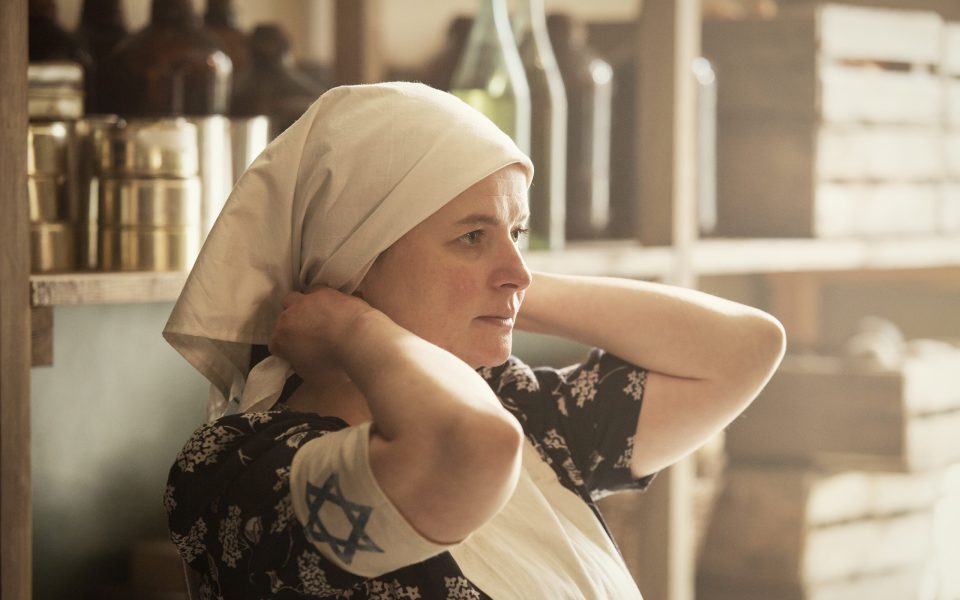Eighty-thousand Jews, among other targets of the German Nazi regime, died of typhus and starvation during the first year of internment in the Warsaw ghetto, the largest of the more than 20,000 confinement centers which, at its height, housed more than 400,000 occupants in an area of about 1.3 square miles.
On Sunday, International Holocaust Remembrance Day, Winston-Salemites gathered at a/perture Cinema for the world premiere of Who Will Write Our History, a documentary that uplifts the lived experiences behind horrific statistics. The film, directed by Roberta Grossman and produced by Nancy Spielberg, is based on historian Samuel Kassov’s book by the same title. It combines interviews with leading scholars, original footage shot by Germans for use in propaganda films and historically-informed, dramatic scenes that endeavor to fill the gap in the historical record from the perspective of Holocaust victims. All dramatic dialogue is sourced from the Oneg-Shabbat Archives, more than 60,000 documents compiled in the ghetto between entrapment of Jews in November 1940 and their mass deportation to the Treblinka extermination camp in July 1942, at which point the project’s architect Emanuel Ringelblum directed the archives to be buried. The contents of two burial sites rest in the Emanuel Ringelblum Jewish Historical Institute in Warsaw; the third site is yet to be recovered from under the once-leveled cityscape.
Who Will Write Our History revolves around the narratives of a handful of the roughly 60-member clandestine collective of journalists, historians, artists, rabbis and community leaders who, as members of the Oneg-Shabbat collective, amassed tens of thousands of artifacts during German occupation, documenting Nazi atrocities and human anguish in the swiftly impoverished, overcrowded ghetto.

“They write their own works of scholarship about life in the ghetto and then they recruit hundreds of people to collect everything they can, whether it’s newspapers printed by the authorities, underground newspapers printed by resistance organizations, but also jokes that Jews are telling one another just to get through their worsening situation, candy wrappers, comic books, anything they can, they put into this archive,” Wake Forest professor Barry Trachtenberg, director of the Program in Jewish Studies, said as he offered context before the screening.
In alignment with the Oneg-Shabbat project’s ethos, the film affirmed the value of ordinary people’s experiences; dramatic scenes play out like illustrations of journal entries and juxtapose grainy, black-and-white Nazi footage.
“For a very long time, most historians of the Holocaust dismissed Jewish voices, almost entirely,” Trachtenberg said post-screening, as he guided discussion amongst the audience. “Many of these were Jewish historians, some survivors of the Holocaust, some refugees from Germany or Austria. They felt that witness voices were unreliable, that they could not be trusted and there was no way to verify what was being said in these works, and they relied almost exclusively on German documents, official Nazi records and propaganda.”

He said that the Soviet regime then silenced Jewish survivor-historians, adding that “those voices of survivors disappeared for decades” until Holocaust memoirs cropped up in the popular consciousness.
The Diary of Anne Frank isn’t straightforward testimony, though, as the audience learned; the published version is an amalgam of her diary, her retrospective creative nonfiction revisions and the final revisions by her father Otto Frank. Elie Weisel’s Night originated as an angry Yiddish-language manuscript before the publisher forced a re-write.
Post-screening, audience discussion centered the ways in which survivor stories are framed for consumption, and the importance of re-examining marginalized histories. One audience member called into question the filmmaker’s decision to occasionally superimpose actors on photographic scenery:
“We know there are people denying this [history] and my fear would be that they would say that’s on the edge of fabricating something,” she said. “There’s no fabricating what we saw. If anyone would use that as an argument, I’d hope people would just stand up and say, ‘That’s impossible.’ You can’t fabricate that kind of horror.”
Who Will Tell Our History filmmakers make a point to open the film with footage of violent manifestations of contemporary anti-Semitism, notably a view of handmade memorials for the 11 murdered victims of a mass shooting in a Pittsburgh synagogue last year — all reminders that anti-Semitism endures.
“We often think of the past as a narrative and we want… those endings to be uplifting,” Trachtenberg said. “Even here, there’s something of a natural arc: in the end, they find the [archival] materials. But then you realize there’s no compensation, there’s no happy ending to this story, nothing good came out of it with this amount of destruction and devastation and nothing can make up for it.”
“It’s one of those things we have to keep probing and examining and questioning, and I think projects like this archive make ethical demands upon us because they were writing so that their voices would not be silenced,” he added. “I believe the making of this film, our viewing of this film… means that we are making an ethical choice to take this burden on, of witnessing and remembering, and I can’t think of a more important task.”
Join the First Amendment Society, a membership that goes directly to funding TCB‘s newsroom.
We believe that reporting can save the world.
The TCB First Amendment Society recognizes the vital role of a free, unfettered press with a bundling of local experiences designed to build community, and unique engagements with our newsroom that will help you understand, and shape, local journalism’s critical role in uplifting the people in our cities.
All revenue goes directly into the newsroom as reporters’ salaries and freelance commissions.


Leave a Reply